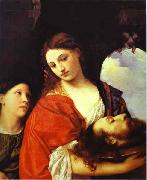
|
Artists
Index
|
||
|
Titian
|
||
|
This early portrait new21/Titian-924378.jpg Painting ID:: 61109 |
This early portrait (c. 1512) was long wrongly believed to be of Ariosto; it is more likely a self-portrait, and the composition was borrowed by Rembrandt for his own self-portraits. | |
| |
|
|
|
|
||
|
Salome, or Judith new21/Titian-884635.jpg Painting ID:: 61118 |
Salome, or Judith; this religious work also functions as an idealized portrait of a beauty, a genre developed by Titian, supposedly often using Venetian courtesans as models. | |
| |
|
|
|
|
||
|
It took Titian two years new21/Titian-259524.jpg Painting ID:: 61120 |
It took Titian two years (1516?C1518) to complete the oil painting Assunta, whose dynamic three-tier composition and color scheme established him as the preeminent painter north of Rome. | |
| |
|
|
|
|
||
|
Titian state portrait of Emperor Charles V at Mehlberg established a new genre, new21/Titian-233245.jpg Painting ID:: 61135 |
Titian's state portrait of Emperor Charles V at Mehlberg (1548) established a new genre, that of the grand equestrian portrait. The composition is steeped both in the Roman tradition of equestrian sculpture and in the medieval representations of an ideal Christian knight, but the weary figure and face have a subtlety few such representations attempt. | |
| |
|
|
|
|
||
|
Titian unmatched handling of color is exemplified by his Danae, new21/Titian-493557.jpg Painting ID:: 61136 |
Titian's unmatched handling of color is exemplified by his Danae, one of several mythological paintings, or "poesie" ("poems") as the painter called them, done for Philip II of Spain. Although Michelangelo adjudged this piece deficient from the point of view of drawing, Titian and his studio produced several versions for other patrons. | |
| |
|
|
|
|
||
| Prev artist | ||
|
Also Buy::. For Following Paintings / Artists / Products, Please Use Our Search Online: |











